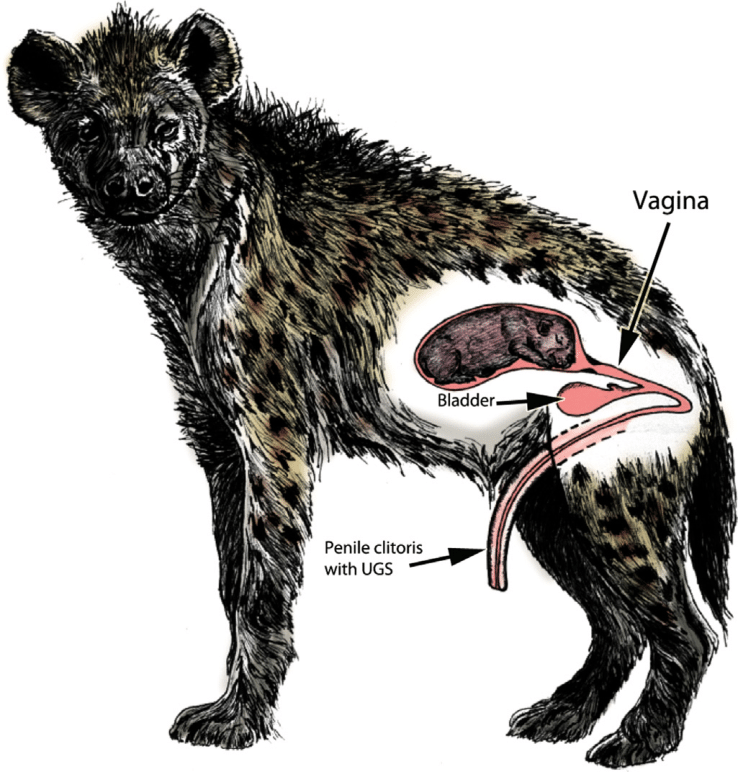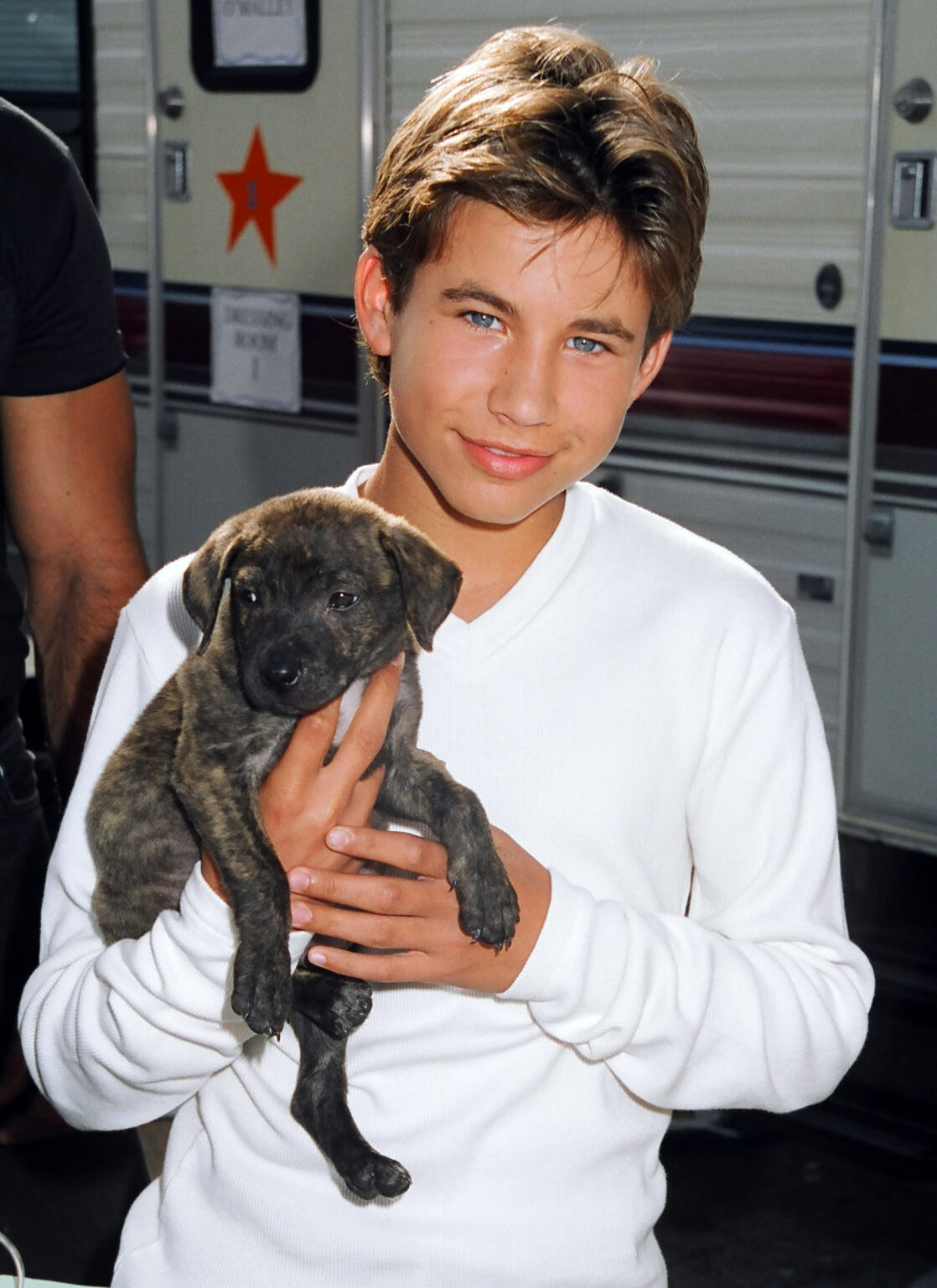Nature is full of fascinating and sometimes brutal adaptations, but few are as shocking as the birthing process of the spotted hyena. You might think childbirth is a universally painful experience, but hyenas take it to an entirely new level.
Female hyenas have one of the most unusual reproductive anatomies in the animal kingdom—what appears to be a penis is actually an elongated clitoris, known as a pseudo-penis. This rare adaptation makes mating, birth, and survival incredibly difficult for both mother and cubs.
Let’s dive into the science, struggles, and evolutionary mysteries behind why hyenas experience one of the most challenging births in the wild.
Hyenas’ Unique Reproductive Anatomy: A Bizarre Evolutionary Twist

The female spotted hyena (Crocuta crocuta) is unlike any other mammal when it comes to reproduction. Unlike most female mammals, hyenas have no external vaginal opening. Instead, their labia are fused together, forming a pseudo-scrotum, and their clitoris is elongated into what resembles a fully functional penis.
This means that both mating and giving birth happen through a narrow, tough, and inflexible canal—a structure that poses serious risks to both mother and cubs.
But why would evolution favor such an extreme adaptation? The answer lies in hyena social structure and dominance.
The Link Between Dominance and Reproductive Anatomy
Hyenas live in strict matriarchal societies, where females outrank males in dominance. The unusual reproductive anatomy is believed to be an evolutionary adaptation linked to social hierarchy.
- A Display of Strength: A larger pseudo-penis might act as a dominance signal, making it clear which females hold power in the clan.
- Hormonal Influence: Female hyenas have higher testosterone levels than males, leading to increased aggression and dominance over the pack.
- Mating Challenges: Males must earn the right to mate, as females control copulation with their complicated anatomy.
Video : Hyenas’ Brutal Birth: The Most Painful Labor in the Animal Kingdom
While this system gives females power, it comes at a terrible cost when it’s time to give birth.
Why Giving Birth Is So Dangerous for Hyenas
Imagine trying to push a newborn through a passage too small, too rigid, and highly prone to tearing. That’s exactly what female hyenas go through every time they give birth.
Here’s what makes hyena birth so deadly:
- A Super Tight Birth Canal
- The pseudo-penis acts as the only birth canal, but it is long, narrow, and lacks the elasticity of a normal vagina.
- This makes labor extremely difficult and painful, with a high chance of the tissue tearing.
- First-Time Mothers Face the Worst Risks
- Many first-time mothers do not survive the birthing process due to severe ruptures.
- Those who do survive often suffer from long-term damage to their reproductive organs.
- High Cub Mortality Rate
- A staggering 60% of hyena cubs suffocate before they are fully delivered.
- Since the birth canal is so tight, cubs often become trapped and die before they can emerge.
- A Painful Recovery Process
- After birth, the pseudo-penis often ruptures completely, forcing it to heal over time.
- Mothers suffer weeks of pain and vulnerability while their bodies recover.
Despite these brutal challenges, hyenas continue to thrive, and their unique reproductive system has remained largely unchanged for millions of years.
How Do Hyenas Mate? The Struggles of Reproduction

If you think birth is difficult for hyenas, mating is no easier. Males must overcome significant anatomical and social obstacles just to reproduce.
- Males Are Submissive to Females
- Unlike in many species where males dominate, male hyenas are the weaker sex in both power and ranking.
- They must approach females cautiously, often displaying submissive behavior to gain approval.
- Navigating the Pseudo-Penis
- Since females have no traditional vaginal opening, males must carefully maneuver through the pseudo-penis to copulate successfully.
- This requires both patience and precise positioning, making it one of the most complex mating processes in the animal world.
- Only the Strongest Males Get to Reproduce
- Males don’t fight each other for dominance like in other species. Instead, they must earn the female’s trust over time.
- Females choose mates based on persistence, patience, and respect, ensuring only the most determined males pass on their genes.

Given how dangerous and inefficient the reproductive process is for hyenas, one might wonder why evolution hasn’t corrected this issue.
The answer lies in survival strategy and social dynamics.
- Matriarchal Control Guarantees Stronger Cubs
- By limiting mating to only the most persistent males, female hyenas ensure that their cubs inherit strong genetics.
- This method prevents weaker genes from spreading, keeping the species robust.
- Higher Testosterone Helps With Survival
- The same high testosterone that makes birth difficult also makes female hyenas stronger and more aggressive.
- This aggression helps protect their cubs and maintain dominance in their environment.
- Fewer Cubs = More Resources
- Since many cubs don’t survive birth, the ones that do are often given more attention and resources.
- This ensures the strongest cubs make it to adulthood, increasing the clan’s overall survival rate.
The Resilience of the Spotted Hyena
Despite their brutal birthing process, hyenas have thrived for millions of years. Their ability to adapt, dominate, and survive proves just how powerful evolutionary trade-offs can be.
- They are among Africa’s most successful predators, competing with lions for food.
- Their clans are ruled by powerful females, ensuring only the strongest members survive.
- They have some of the most advanced social structures in the animal kingdom, making them highly intelligent and strategic.
Video : The Most Extreme Births In The Animal Kingdom
Conclusion: Nature’s Ultimate Test of Survival
Hyenas are proof that nature often prioritizes survival over comfort. Their unique reproductive anatomy, extreme birthing challenges, and dominance-driven society have allowed them to thrive despite overwhelming odds.
While their birth process remains one of the most painful and deadly in the animal kingdom, it also ensures that only the strongest females and cubs survive.
So the next time you see a spotted hyena, remember—they’re not just fierce scavengers. They’re survivors of one of evolution’s toughest reproductive challenges.
This teen heartthrob deemed as gay basically vanished after, Home Improvement, Well, after all these years he is finally surfaced again, and users say he is barely recognizable, My goodness, he looks so different

At the height of his fame, a beloved teen heartthrob made a shocking decision to step away from the Hollywood spotlight, leaving countless young fans yearning for more.
This former star of a popular 90s sitcom, who recently celebrated his 43rd birthday, was last seen in 2023, prompting nostalgia and disbelief among those who once had a crush on him.
So, what happened to the enigmatic actor known for voicing a classic Disney character in a beloved animated film? Dive in to uncover the story behind this mysterious figure!

He first caught the spotlight as Greg Brady’s son on the 1990 TV series The Bradys, a spinoff of The Brady Bunch. However, his true breakthrough arrived shortly after when he secured a role in a popular sitcom alongside a famous comedian, propelling him to stardom.
Only 10 years old when the show premiered in 1991, Thomas grew up on-screen as Randy, the middle child, during the show’s eight-year run. His charm and charisma propelled him to teen idol status, winning the hearts of millions.

Reflecting on his fame, Thomas told The New York Times, “You’re part of their lives, and there’s a lot owed to them. But it’s hard because you want to make everyone happy, and if you try, you set yourself up for failure.”
In 1994, at the age of 12, Thomas voiced the character Simba in Disney’s The Lion King, a role that resonated deeply with fans worldwide.
“Simba’s a lot like me,” Thomas once shared, explaining how he used his natural energy to bring the character to life. “Curious, fun-loving, always getting into mischief.”
Juggling his time between The Lion King and Home Improvement, Thomas spent two intense years moving back and forth between the two productions. “I had to remind myself, ‘Oops! Time to be Randy,’ then, ‘Oops! Time to be Simba,’” he told People in 1994. “You have to prepare yourself to become a totally different person. I mean, we’re not lions, right?”
By 1998, after leaving Home Improvement before its final season, Thomas began to step out of the limelight. “I’ve done so many shows with full-blown migraines,” he said. “I’d been going nonstop since I was 8. I wanted to take a break, go to school, and travel.”
Over the next few years, Thomas made guest appearances on shows like Ally McBeal, Smallville, and 8 Simple Rules, and lent his voice to animated series such as The Wild Thornberrys and The Simpsons.
Before his exit from Hollywood, Thomas challenged himself with more mature roles, including playing a bisexual hustler in the indie film Speedway Junky (1999) and a persecuted gay teen in Showtime’s Common Ground (2000). These roles, coupled with his private nature, sparked rumors about his sexuality, which he addressed on The Tonight Show with Jay Leno.

“In Hollywood, you’re not really anyone until there’s a rumor you’re gay,” he said. “It didn’t bother me, but they’re just rumors. Be careful with that internet stuff.” He later told The Advocate that the rumors started on a site called CyberSleaze and were entirely false. “It was a blatant lie that snowballed, and people accepted it without question,” he said.
In the early 2000s, Thomas shocked fans by stepping away from Hollywood to pursue higher education. After graduating from New York’s Chaminade College Preparatory School in 2000, he attended Harvard University, where he studied philosophy and history, before later graduating from Columbia University in 2010.
“I never took fame too seriously,” Thomas said of his Hollywood career. “It was a great time in my life, but it doesn’t define me.” He admitted that walking through libraries and attending classes was a refreshing and novel experience for him.
Although he left Hollywood behind, Thomas reunited with Tim Allen for several guest appearances on Last Man Standing between 2013 and 2015, even directing a few episodes of the series.
In 2023, fans were once again buzzing after spotting Thomas walking his dogs in public. Dressed casually in a beige sweater, jeans, and a black toque, his appearance stirred nostalgic feelings among fans.
“JTT, my elementary school crush,” one fan gushed, while another reflected, “He was my childhood crush, and I’m glad he avoided the weirdness of Hollywood.”
A third fan added, “He was a child star and a teen heartthrob. Hollywood doesn’t treat child actors well, so who knows what he went through.”

Another fan, referencing his famous bowl cut from Home Improvement, quipped, “Of course, he looks different! Not many 42-year-olds are walking around with bowl haircuts. He brought joy to so many with his early career.”
Despite his rare public appearances, Jonathan Taylor Thomas remains a cherished figure from the 90s, remembered fondly for his work in Home Improvement and The Lion King, and for his decision to walk away from fame on his own terms.



Leave a Reply